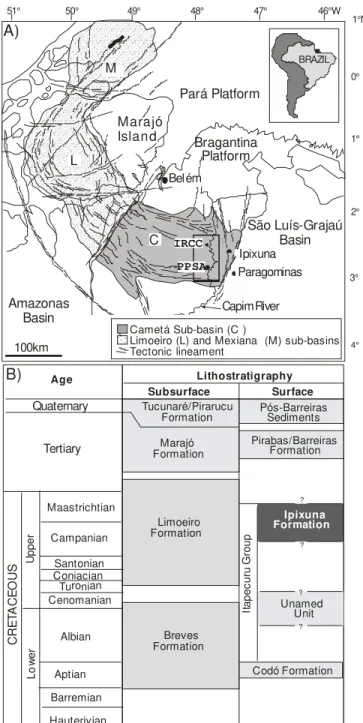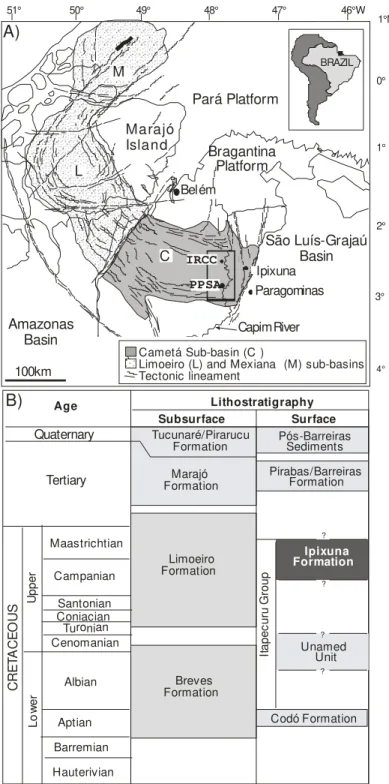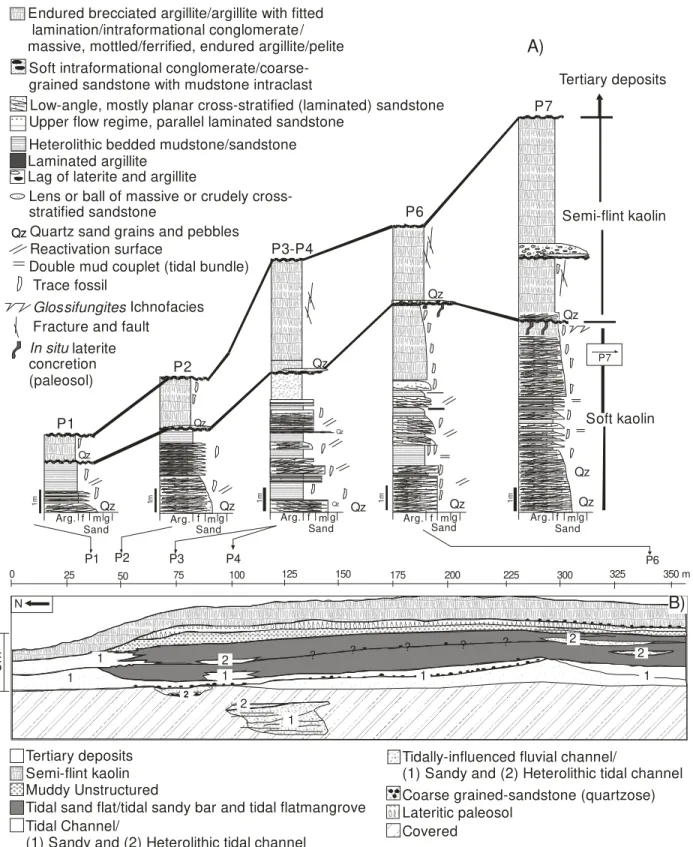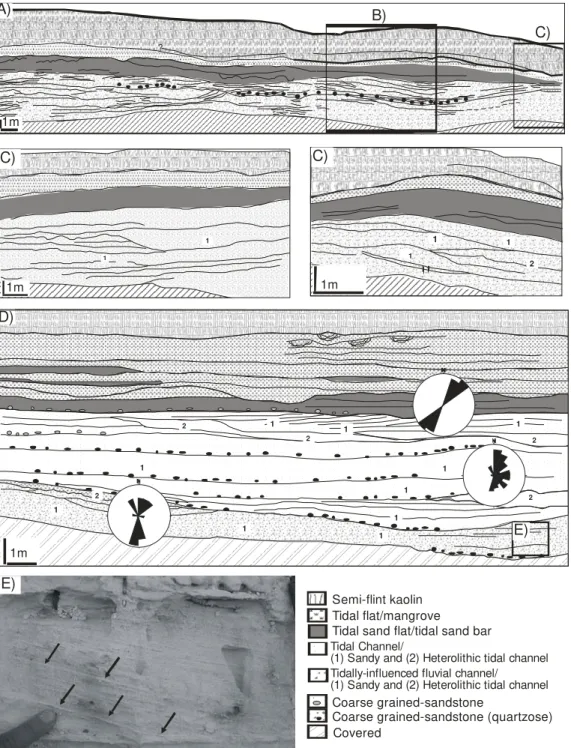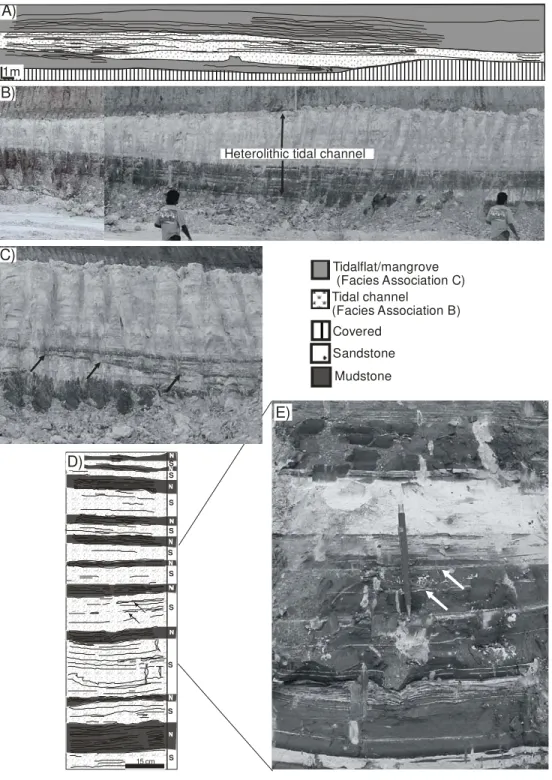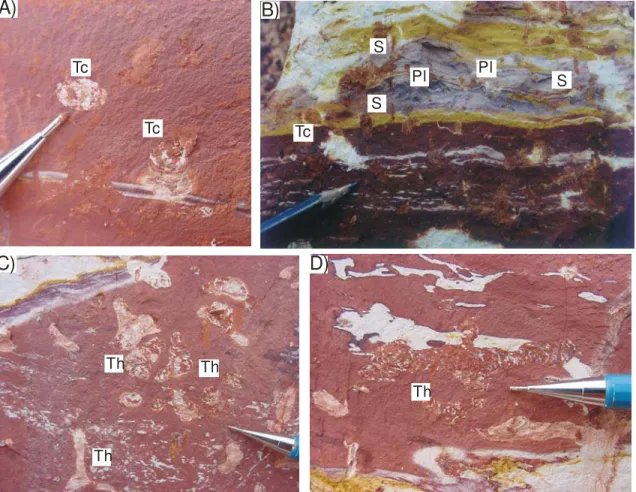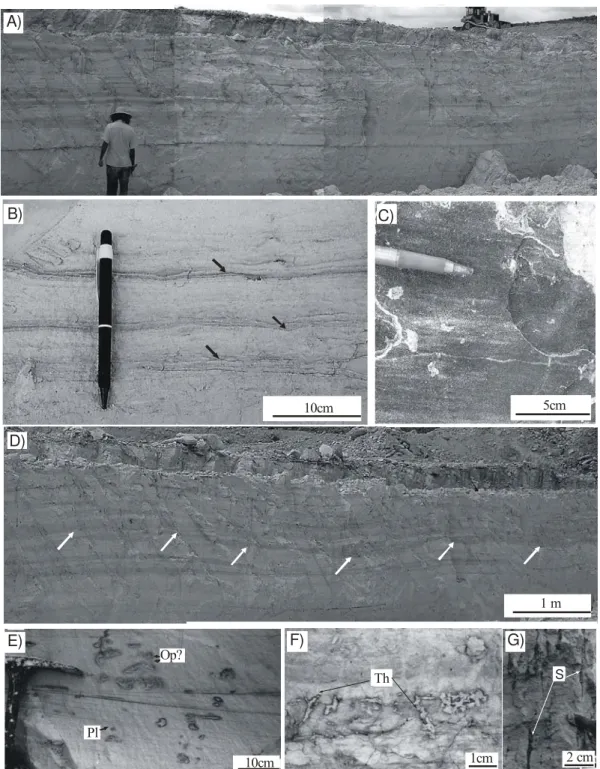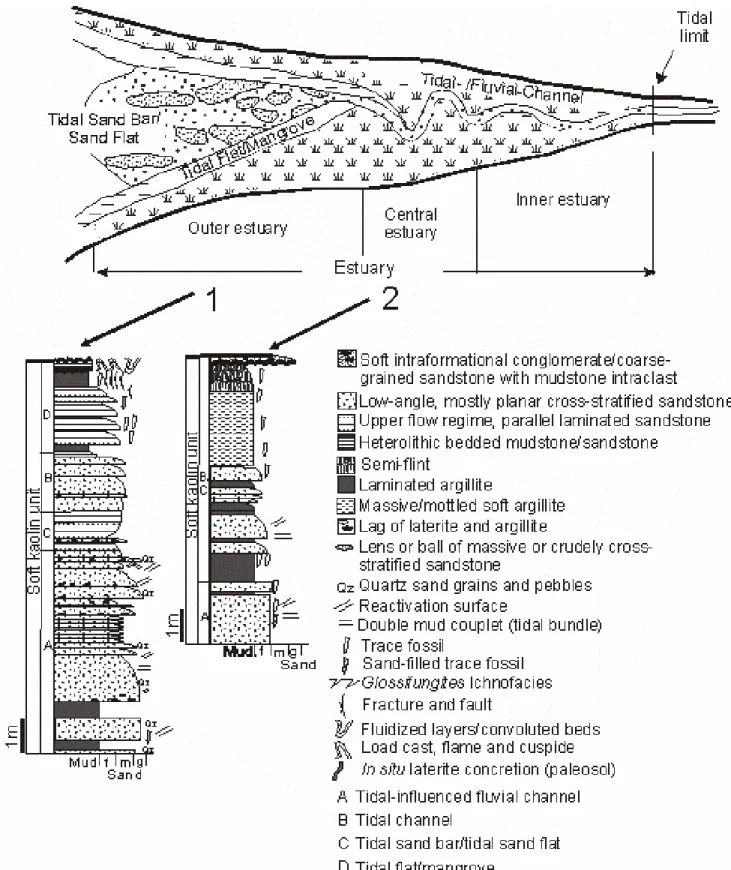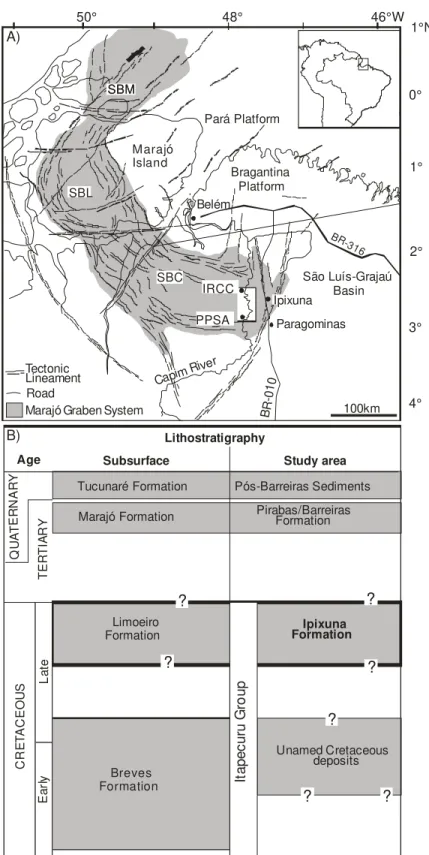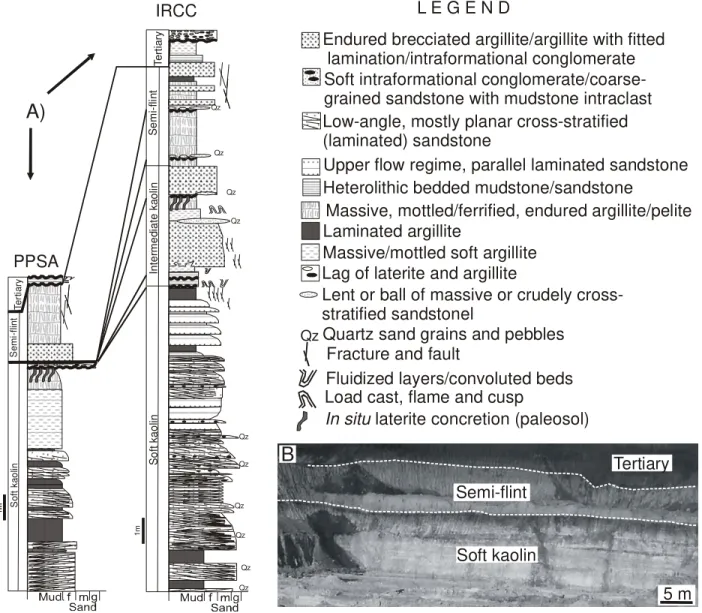Universidade Federal do Pará
Centro de Geociências
Curso de Pós-Graduação em Geologia e Geoquímica
ANÁLISE INTEGRADA DOS DEPÓSITOS DE CAULIM NA REGIÃO DO
RIO CAPIM: FÁCIES, ESTRATIGRAFIA, PETROGRAFIA E ISÓTOPOS
ESTÁVEIS
TESE APRESENTADA POR
ANTÔNIO EMÍDIO DE ARAÚJO SANTOS JÚNIOR
Como requisito parcial à obtenção do Grau de Doutor em
Ciências na Área de GEOLOGIA
Data de aprovação: 29/09/2006
Comitê de Tese
DILCE DE FÁTIMA ROSSETTI (orientadora)
ALCIDES NÓBREGA SIAL
VALDEREZ PINTO FERREIRA
BASILE KOTSCHOUBEY
WERNER TRUCKENBRODT
DEDICATÓRIA
AGRADECIMENTOS
À Dilce de Fátima Rossetti e Haydn H. Murray pela orientação.
Ao CNPq pela concessão de bolsa de estudo; ao Museu Paraense Emílio Goeldi (MPEG) pela infra-estrutura concedida durante a maior parte deste trabalho; à Universidade Federal do Pará (UFPA), através do Centro de Pesquisa de Pós-Graduação de Geologia e Geoquímica (CPGG), e à Universidade de Indiana (IU) pela oportunidade de intercâmbio acadêmico e realização das análises de isótopos estáveis.
Às minas Imery Rio Capim Caulim (IRCC) e Pará Pigmentos (PPSA) pelo suporte logístico e oportunidade de acesso às minas.
À banca examinadora: Alcides Nóbrega Sial, Valderez Pinto Ferreira, Basile Kotschoubey e Werner Trucenbrodt.
À Ana Maria Góes, Renata Guimarães, Marivaldo Nascimento, Jackson Paz, Lena Barata, Heloísa Moraes, Junny kyley, Luciana Melo, Margareth Martins, Sara Rodrigues, Daniel Vitória,
Glória Soeiro, Mônica Lima, e aos amigos do Museu Goeldi e UFPA. Aos geólogos Carlos Henrique e Sá Pereira, e Engenheiro Leonardo.
Sumário
DEDICATÓRIA ...I
AGRADECIMENTOS...II
LISTA DE ILUSTRAÇÕES ... V
FIGURAS ... V
TABELA... VIII
RESUMO...1
ABSTRACT...4
APRESENTAÇÃO ...6
1 INTRODUÇÃO ...7
1.1 CONTEXTO GEOLÓGICO E RELEVÂNCIAS DO TRABALHO ... 7
1.2 OBJETIVOS... 10
1.3 MÉTODOS... 11
REFERÊNCIAS BIBLIOGRÁFICAS...12
2. DEPOSITIONAL MODEL OF THE IPIXUNA FORMATION (LATE CRETACEOUS-?EARLY TERTIARY), RIO CAPIM AREA, NORTHERN BRAZIL...15
2.1 ABSTRACT ... 15
2.2 INTRODUCTION ... 16
2.3 GEOLOGICAL FRAMEWORK ... 18
2.4 FACIES ANALYSIS OF THE SOFT KAOLIN... 20
2.4.1 Facies Association A: Tidally influenced Fluvial Channel ... 20
2.4.2 Facies Association B: Tidal Channel ... 24
2.4.3 Facies Association C – Tidal Flat/?Mangrove ... 29
2.4.4 Facies Association D – Upper Flow Regime Tidal Sand Flat/Sand Bar... 30
2.6 CONCLUSION ...38
REFERENCES...39
ACKNOWLEDGEMENTS...44
3. ORIGIN OF THE RIO CAPIM KAOLIN WITH BASIS ON OPTICAL (PETROGRAPHIC AND SEM) DATA...45
3.1 ABSTRACT ... 45
3.2 INTRODUCTION ... 46
3.3 GEOLOGICAL FRAMEWORK ... 47
3.4 METHODS... 51
3.5 DESCRIPTION OF THE KAOLIN UNITS ... 51
3.5.1 Soft kaolin... 51
3.5.2 Intermediate and semi-flint kaolin units ... 59
3.6 DISCUSSION... 62
3.6.1 Composition and genesis of the soft kaolin unit ... 63
3.6.2 Composition and genesis of the semi flint kaolin unit... 65
3.7 FINAL REMARKS ... 68
REFERENCES...70
ACKNOWLEDGMENTS...75
4. ORIGIN OF THE RIO CAPIM KAOLINITES (NORTHERN BRAZIL) REVEALED BY
δ
18O ANDδ
D ISOTOPE ANALYSES ...764.1 ABSTRACT ... 76
4.2 INTRODUCTION ... 77
4.3 GEOLOGY... 78
4.4 METHODS... 83
4.4.1 δ18O and δD isotope data... 84
4.5 DISCUSSION... 90
4.5.1 Evaluating the influence of the modern meteoric water... 90
4.5.2 Isotope behavior of the Ka+Kb kaolinites... 92
4.6 CONCLUSIONS ... 98
REFERENCES...100
ACKNOWLEDGEMENTS...107
LISTA DE ILUSTRAÇÕES FIGURAS
Figura 1.1: A) Mapa de localização da área de estudo, Sub-Bacia de Cametá, Sistema de Graben do Marajó, com indicação das minas de caulim estudadas, PPSA e RCC. SBC=Sub-Bacia de Cametá, SBL=Sub-Bacia de Limoeiro e SBM=Sub-Bacia de Mexiana. B) Carta Litoestratigráfica da Sub-Bacia de Cametá...8 Figure 2.1: A) Location map of the study area in the Rio Capim area, Cametá Sub-Basin, with the studied kaolin quarries PPSA and RCC indicated. B) Stratigraphic chart representing the sedimentary successions in the Cametá Sub-Basin, both in the subsurface and surface exposures………17 Figure 2.2: Measured lithostratigraphic profiles (A) and geologic cross-section (B) illustrating the sedimentologic characteristics and spatial distributions of facies and facies associations present in the soft kaolin unit of the Ipixuna Formation in the PPSA quarry. Profile P7 is not in shown this geological section, being located circa 200 m to the south………19 Figure 2.3: A-D) Representative geologic sections, illustrating the sedimentologic characteristics and spatial distributions of facies and facies associations of the soft kaolin unit of the Ipixuna Formation in the RCC quarry. Note that B and C are close-ups of Figure A, illustrating the tidally-influenced fluvial channel deposits (Facies Association A). Observe, also, that D contains rose diagrams with paleocurrent data obtained from cross-stratified sandstones of tidally influenced fluvial channel (Facies Association A) and tidal channel (Facies Association B), as well as parting lineation of upper flow regime tidal sand flat/sand bar (Facies Association D) deposits. E) Close-up photograph of tidal-influenced fluvial channel deposits (Facies Association A), showing foreset packages with mud drapes (arrows)………22 Figure 2.4: Tidal channel (Facies Association B) and tidal flat/mangrove (Facies Association C). A) Geologic section illustrating the spatial relationship between facies associations B and C. Note the gentle concave upward surface that defines the base of a tidal channel deposit. B) General view of a heterolithic tidal channel deposit (man = 1.65 m tall). Dark color = muddier deposits. C) Detail of the sharp, erosional base of a heterolithic tidal channel. D) Heterolithic deposits typical of facies associations B and C, illustrating a vertical succession attributed to tidal bundles. These consist of rhythmically alternating sandier (spring) and muddier (neap) cycles (S=spring; N=neap). Mud couplets attributed to ebb/flood fluctuation are locally present in some spring cycles (black arrows), and undetermined trace fossils are common (white arrows)………26 Figure 2.5: A-D) Details of trace fossils representative of tidal channel (Facies Association B) and tidal flat/mangrove deposits (Facies Association C): Thalassinoides (Th), Planolites (Pl),
Figure 2.6: Upper flow regime tidal sand flat/sand bar (Facies Association D). A) General view of an outcrop illustrating tabular sandstones with horizontal to low-angle dipping cross stratification (Facies St) (man=1.65 m tall). B) Horizontal lamination with laminae highlighted by heavy minerals. C) Sandstone with parting lineation (pencil oriented parallel to paleoflow). D) Undulating lamination forming scour or swales locally filled by mudstone (white arrows). E-G) Trace fossils, representative of the upper flow regime tidal sand flat/sand bar. Thalassinoides
Figure 4.2 Types of kaolinites from the Rio Capim area. A-B) Ka and Kb kaolinites, typical of sandstones (A) and mudstones (B) of the soft kaolim unit, respectively. C) Kc kaolinite, typical of the semi-flint kaolin unit. D) Kaolinite booklets………82 Figure 4.3 Lithostratigraphic profiles of the PPSA quarry, with the corresponding δD and δ18O isotope values……….…87 Figure 4.4 Lithostratigraphic profiles of the IRCC quarry, with the corresponding δD and δ18O isotope values (See figure 3 for legend)……….88 Figure 4.5 Binary diagram with plots of δD and δ18O isotopic values of the kaolinites of the study area, as well as of the modern meteoric water and groundwater. Also plotted are the kaolinite line (Savin and Epstein, 1970a), the supergene/hypogene line (Sheppard et al., 1969) and the meteoric water line (Craig, 1961). See text for discussions……….89
TABELA
Os depósitos de caulim que ocorrem na porção média do Rio Capim, leste da Sub-Bacia de Cameta, inserem-se na Formação Ipixuna, de idade cretácea superior, a qual se destaca por apresentar uma das maiores concentrações mundiais de caulim de excelente qualidade para a indústria de celulose. Um grande volume de trabalhos acadêmicos com enfoque geoquímico foi conduzido nestes depósitos, porém sem levar em consideração os aspectos faciológicos e estratigráficos, que são relevantes para entender sua origem e ocorrência. Somente recentemente, trabalhos sedimentológicos e estratigráficos mais detalhados destes depósitos de caulim foram apresentados, o que gerou uma série de novas considerações a respeito dos paleoambientes de deposição. Este tipo de estudo despertou interesse para se conduzir uma investigação integrada considerando-se aspectos sedimentológicos, estratigráficos, petrográficos e isótopos estáveis de hidrogênio e oxigênio, a fim de discutir os processos geológicos que podem ter influenciado na origem e evolução dos depósitos de caulim softe semi-flint da Formação Ipixuna.
A análise sedimentológica e estratigráfica apresentada neste estudo teve caráter complementar a investigações anteriores, tomando-se por base a presença de novas exposições ao longo das frentes de lavra que disponibilizaram novas informações importantes ao entendimento dos ambientes de deposição. Assim, a porção inferior da Formação Inpixuna caracteriza-se por uma unidade de caulim do tipo soft, o qual por apresentar-se com preservação das estruturas primárias, possibilitou melhor entendimento dos processos de sedimentação. Estes depósitos incluem principalmente arenitos e argilitos caulinizados formados em ambientes de canal de maré influenciado por sistema fluvial (associação de fácies A), canal de maré (associação de fácies B), planície de maré/mangue (associação de fácies C), e barra/planície de areia dominada por maré (associação de fácies D). Estes depósitos são atribuídos a sistema estuarino do tipo dominado por maré. A unidade superior, conhecida como semi-flint, é dominantemente maciça, porém um estudo em paralelo conduzido durante o desenvolvimento desta tese revelou a presença de lobos deltaicos e canais distributários.
O estudo petrográfico e de microscopia eletrônica de varredura nos depósitos estudados levou à melhor caracterização textural dos tipos de caulinita presentes nas unidades de kaolin soft
caracterizados por arenitos quartzosos caulinizados e pelitos laminados ou maciços, os quais são compostos por fragmentos líticos de rochas meta-vulcânicas e vulcânicas félsicas, bem como rochas metamórficas e graníticas. Estas litologias foram fortemente modificadas durante o processo de caulinização da Formação Ipixuna, processo que teria obliterado a composição primária dos grãos do arcabouço. Durante este processo, três tipos principais de caulinita foram geradas, definidas com base no tamanho e textura como Ka, Kb e Kc. A caulinita Ka ocorre dominantemente associada aos arenitos caulinizados, sendo caracterizada por cristais pseudohexagonais a hexagonais, com diâmetros de 10-30 µm, podendo ocorrer na forma de aglomerados formando “livretos” (booklets) ou sob forma vermicular contendo até 400 µm de comprimento. A caulinita Kb ocorre dominantemente nos pelitos, consistindo de cristais pseudohexagonais a hexagonais de 1-3 µm de diâmetro, ocorrendo na forma isolada, formando intercrescimentos dos tipos caótico, face-a-face, paralelo a pseudo-paralelo. A caulinita Kc ocorre como cristais pseudohexagonais a hexagonais com diâmetros regulares de 200 nm. Sua distribuição é dispersa ao longo da unidade de caulim soft, aumentando em abundância em níveis de paleossolo que ocorre no topo da unidade. Os depósitos de caulim semi-flint são constituídos principalmente de grãos retrabalhados dos depósitos de caulim soft e grãos provenientes de rocha-fontes metamórficas e graníticas. As caulinitas da unidade de semi-flint são dominantemente representadas por caolinita Kc, gerada principalmente durante intemperismo pretérito.
As integração de estudos faciológicos, estratigráficos, ópticos e isótopos estáveis de deutério (δD) e oxigênio (δ18O) dos depósitos de caulim do Rio Capim permitiu melhor entender a gênese e evolução dos tipos de caolinita Ka+Kb e Kc. Os depósitos de caulim soft apresentam valores de δ18O variando de 6,04‰ a 19,18‰ nas caulinitas Ka e Kb, e de 15,38‰ a 24,86‰ nas caulinitas Kc. Os valores de δD variam de –63,06‰ a 79,46‰, e de –68,85‰ a –244,35‰, respectivamente. Os depósitos de caulim semi-flint são caracterizados por valores isotópicos de
δ18
ABSTRACT
The kaolin deposits that occur in the Rio Capim area, east of Cametá Sub-Basin, are inserted in the Ipixuna Formation. This unit distinguishs for presenting one of the largest worldwide kaolin concentrations of excellent quality to the cellulose industry. Beyond the economic character, a great volume of academic works focusing these kaolin deposits had led to pedological and geochemical approaches, but without taking into account their sedimentologic aspects, which are important to understand their genesis. Detailed sedimentologic and stratigraphic studies of the Rio Capim kaolin have been increasingly carried out in the last years, which led to the paleoenvironmental interpretations for the Ipixuna Formation, as well as to discuss better the mode of formation of the soft and semi-flint kaolin units that are typical of this unit. These works served to motivate the integration of sedimentologic and stratigraphic data with optical studies combined with hydrogen and oxygen isotope geochemistry in order to discuss the geologic processes involved in the origin and evolution of the soft and semi-flint kaolin units. The sedimentological analysis consisted in a more detailed facies description and stratigraphic analysis of newly open quarries that were not available during previous investigations. The additional exposures led to a better characterization of the lower kaolin unit, known as the “soft kaolin”, which is well stratified, favoring facies analysis. Hence, the soft kaolin unit consists of kaolinitized sandstones and kaolinitized pelites that were formed in tidally influenced fluvial channels (Facies Association A), tidal channel (Facies Association B), tidal flat/mangrove (Facies Association C), and tidal sand bar/tidal sandy flat (Facies Association D). These depositional environments are attributed to a tide-dominated estuarine system.
dominantes in the pelites, and consists of pseudohexagonal crystals 1-3 µm in diameter, occurring as isolated, face-to-face and parallel to pseudo-parallel crystals. Kc kaolinite forms pseudohexagonal to hexagonal crystals of 200 nm in diameter. It occurs dispersed through the soft unit, increasing significantly in abundance in association with paleosols at the top of the unit. The semi-flint kaolin deposits are constituted mainly of reworked grains derived from the underlying soft kaolin unit that are mixed with grains derived from metamorphic and granitic sources. These deposits are dominantly composed of Kc kaolinite that was formed during weathering.
The deuterium (δD) and oxygen (δO) isotope analysis of the kaolin deposits from the study area helped to discuss better the evolution of the different types of kaolinites described above. Hence, the soft kaolin deposits display δO values varying between 6.04 ‰ and 19.18 ‰ in the Ka+Kb kaolinites, and between 15.38 ‰ and 24.86 ‰ in the Kc kaolinite. The δD values from this unit vary from – 63.06 ‰ to 79.46 ‰, and from –68.85‰ to -244.35‰ in the Ka+Kb and Kc kaolinites, respectively. The semi-flint kaolin deposits are characterized by δO and δD values ranging from 15.08‰ to 21.77‰, and from -71.31‰ to -87.37‰, respectively. Based on these data and on the isotopic composition of both meteoric and ground waters, it was possible to conclude that the kaolinites had not been formed in balance with modern weathering. These values represent the isotopic composition during the time of formation of the kaolinites, as well as mineralogical contamination of framework grains that are now replaced by kaolinites.
APRESENTAÇÃO
1 INTRODUÇÃO
1.1 CONTEXTO GEOLÓGICO E RELEVÂNCIAS DO TRABALHO
3° 2° 1° 0° 1°N 48° 49° 50° 51° Marajó Island 47° 46°W 100km Amazonas Basin São Luís-Grajaú Basin Pará Platform Bragantina Platform Ipixuna Paragominas IRCC PPSA C L BRAZIL M Hauterivian Barremian Aptian Albian Maastrichtian Campanian Santonian Coniacian Turonian Cenomanian Age Lithostratigraphy Subsurface Quaternary Tertiary Lo w er Up p e r CRE T A CE O US Breves Formation Limoeiro Formation Marajó Formation Tucunaré/Pirarucu Formation Ipixuna Formation Pirabas/Barreiras Formation Pós-Barreiras Sediments Surface Unamed Unit I ta pec uru Gro u p Codó Formation ? ? ? ? 4°
Cametá Sub-basin (C )
Limoeiro (L) and Mexiana (M) sub-basins Tectonic lineament
A)
B)
Capim River Belém
compreende uma cobertura sedimentar argilosa, maciça, tendo sua gênese relacionada à: a) formação in situ; b) transporte lateral e deposição de material saprolítico; e c)transporte vertical de material saprolítico por termitas (Truckenbrodt et al., 1991; Kotschoubey et al., 1996; 1999). A correlação estratigráfica entre as unidades descritas em superfície e sub-superfície sugere que os depósitos da Formação Ipixuna compreendem estratos da Formação Limoeiro. Esta interpretação baseia-se no posicionamento estratigráfico acima de depósitos albo-cenomanianos correlacionáveis à Formação Alcântara da Bacia de São Luís-Grajaú, o que leva a sugerir possível idade cretácea superior. Isto é ainda sugerido pela ocorrência de depósitos terciários de idade provável miocênica médio/superior sobrepostos à Formação Ipixuna.
sistematicamente conduzidos até o momento. O conhecimento detalhado das variações de fácies sedimentares de acordo com a caracterização das espécies de caulinita representa uma abordagem inédita sobre o desenvolvimento evolutivo das diferentes fases de caulinita da Formação.
O emprego de isótopos estáveis de oxigênio e hidrogênio como ferramenta para o reconhecimento de minerais intempéricos formados em tempos e, portanto, condições paleoambientais distintas podem revelar condições de equilíbrio isotópico com seu ambiente genético, já que uma vez formados, estes minerais retém sua assinatura isotópica, refletindo as condições climáticas do tempo de formação (Savin & Hsieh, 1997).
Por fim, os depósitos de caulim da área do Rio Capim são carentes de investigações científicas realizadas de forma integrada (p.e., faciologia, estratigrafia, petrografia e isótopos estáveis de O e H). Sendo assim, este trabalho se propôs à caracterização dos estratos caulínicos na Região do Rio Capim, procedendo-se a uma análise integrada de aspectos sedimentológicos, estratigráficos, ópticos (petrografia e microscopia eletrônica), mineralógicos e geoquímicos, a fim de possibilitar uma discussão sobre os fatores que influenciaram sua origem e evolução da Formação Ipixuna.
1.2 OBJETIVOS
1.3 MÉTODOS
Neste trabalho foram adotadas a seguinte metodologia: análise faciológica/estratigráfica, análise óptica e geoquímica de isótopos de O e H. O estudo faciológico/estratigráfico de detalhe consistiu no mapeamento complementar da arquitetura de fácies deposicionais, e confecção de perfis/seções verticais em novas frentes de lavra observando-se os parâmetros sedimentológicos (p.e., estrutura, textura, mineralogia, padrão de paleocorrentes, traços fósseis e geometria dos corpos sedimentares). Este método foi conduzido nos depósitos cretáceos da Formação Ipixuna na porção média do Rio Capim, devido as novas frentes de lavra regurlamente espostas nas minas da IRCC e PPSA, o que representou a coleta de dados paleoambientais adicionais e contribuiu para o melhor entendimento da dinâmica evolutiva deste sistema estuarino.
O estudo óptico consistiu na análise de 60 seções delgadas sob microscópio petrográfico e eletrônico de varredura, a fim de melhor caracterizar os principais constituintes mineralógicos e entender os processos sin- e pós-deposicionais que controlaram a geração dos diferentes tipos de caulinita. As amostras de caulim foram amostradas seguindo rígido controle faciológico e estratigráfico, de forma a registrar variações litológicas e de processos sedimentares, bem como melhor caracterizar o conteúdo mineralógico e observar os padrões morfológicos das caulinitas. Além disto, tomou-se cautela para se efetuar a coleta de amostras progressivamente abaixo e acima das superfícies de descontinuidade, de forma a possibilitar a análise de possíveis influências de processos associados ao desenvolvimento das mesmas na formação dos diferentes tipos de caulinita.
REFERÊNCIAS BIBLIOGRÁFICAS
ANAISSE JÚNIOR, J. 1999. Fácies costeiras dos Depósitos Itapecuru (cretáceo), região de Açailândia, Bacia do Grajaú. Belém, UFPa. Cento de Geociências. 86p. (Dissertação de Mestrado).
ARAI, M.; UESUGUI, N.; ROSSETTI, D.F.; GÓES, A.M. 1988. Considerações sobre a idade do Grupo Barreiras no nordeste do estado do Pará. In: CONGRESSO BRASILEIRO DE GEOLOGIA, 35, Belém, Anais... Belém, Sociedade Brasileira de Geologia. V.2, p. 738-752
AZEVEDO, R.P. 1991. Tectonic Evolution of Brasilian Equatorial Continental Margin Basins. Royal School of Mines Imperial College, London.412p. (Tese de Doutorado).
GALVÃO, M.V.G., 1991. Evolução Termodinâmica da Bacia do Marajó, estado do Pará, Brasil. Universidade de Ouro Preto. 193p. ( Dissertação de Mestrado).
GÓES, A.M., 1981. Estudo Sedimentológico dos Sedimentos Barreiras, Ipixuna e Itapecuru, no Nordeste do Estado no Pará e Noroeste do Maranhão. Belém. Universidade Federal do Pará. 55 p. (Dissertação de Mestrado).
JUPIASSÚ, A.M.S. 1970. Madeira Fóssil – Humiriaceae de Irituia, Estado do Pará. Boletim do Museu Paraense Emilio Goeldi. Nova Série, 14: 1-12.
KOTSCHOUBEY, B.; DUARTE, A. L. S.; TRUCKENBRODT, W. 1999. Cobertura bauxítica e origem do caulim do Morro do Felipe, Baixo Rio Jari, Estado do Amapá. Revista Brasileira de Geociências. 29:331-338.
KREBS, A.S.J. & ARANTES, J.L.G., 1973. Pesquisa de caulim no Rio Capim, Estado do Pará. In: CONGRESSO BRASILEIRO DE GEOLOGIA, 27, Aracaju, Anais... Aracaju, SBG. V.1, p. 181-191.
MURRAY, H.H. & KELLER, W.D. 1993. Kaolins, Kaolins and Kaolins. In Kaolin Genesis and Utilization, eds. Murray, H., Bundy, W., Harvey, C., pp. 1-24, Clay Mineral Society Special Publication 1.
ROSSETTI, D.F., 1997. Internal Archicteture of mixed tide and storm influenced deposits: an example from the Alcântara Formation, northern Brazil. Sedimentary Geology. 114:163-188.
ROSSETTI, D.F., 2000. Influence of low amplitude/ higth frequency relative sea level changes in a wave-dominated estuary (Miocene), São Luís basin, northern Brazil. Sedimentary Geology, 133: 295-324.
ROSSETTI, D.F., 2001. Sedimentary Evolution of Late Cenozoic Deposits in the Nortears of Pará State, Brasil: Evidence of sea level floctuações. Journal of South Americam Earth Sciences.
ROSSETTI, D.F. & SANTOS JR., A. E., 2003. Events of soft sediment deformation and mass failure in Upper Cretaceous estuarine deposits (Cametá Basin, northern Brazil) as evidence for seismic activity. Sedimentary Geology, 161:107-130.
ROSSETTI, D.F.; GÓES, A.M.; TRUCKENBRODT, W. 1990. A Influência Marinha nos sedimentos Barreiras. Boletim do Museu Paraense Emílio Goeldi. Belém. 2:17-29.
SANTOS JR, A.E.A. 2002. Reconstrução Peloambiental e Estratigráfica de Depósitos Cretáceos e Terciários expostos na borda sudeste da Sub-Bacia de Cametá, Norte do Brasil. Belém. Universidade Fedaral do Pará. Centro de Geociências. P.131 (Dissertação de Mestrado).
SAVIN, S.M. & HSIEH, J.C.C. 1998. The hydrogen and oxygen isotope geochemistry of pedogenic clay minerals: principles and theoretical background. Geoderma. 82:227-253.
SCHALLER, H.; VASCONCELOS, D.N.; CASTRO, J.C., 1971. Estratigrafia Preliminar da Bacia Sedimentar da Foz do Rio Amazonas. In: CONGRESSO BRASILEIRO DE GEOLOGIA, 25., São Paulo. Anais... São Paulo; Sociedade Brasileira de Geologia. V.3, p.189-201.
TRUCKENBRODT, W.; KOTSCHOUBEY, B.; SCHELLMANN, W. 1991. Composition and origin of the clay cover on North Brazilian laterites. Geologische Rundschau, 80:591-610.
2. DEPOSITIONAL MODEL OF THE IPIXUNA FORMATION (LATE
CRETACEOUS-?EARLY TERTIARY), RIO CAPIM AREA, NORTHERN
BRAZIL
Antônio Emídio de Araújo SANTOS Jr
and Dilce de Fátima ROSSETTI
2.1 ABSTRACT
Exposures along open quarries located in the eastern Cametá Sub-Basin provide an opportunity to assess further discussion focusing on the depositional environments of the Upper Cretaceous-?Lower Tertiary Ipixuna Formation. The lower part of this unit emphasized herein, known as the “soft kaolin”, consists mostly of kaolinitized sandstones and mudstones that exhibit well preserved sedimentary structures that are particularly favorable for facies analysis and paleoenvironmental reconstructions. The sandstones are chiefly cross-stratified, typically with low angle, locally reverse oriented foresets with reactivation surfaces and/or mud drapes. These characteristics, together with a trace fossil assemblage consisting of Ophiomorpha, Thalassinoids, Planolites, Teichichnus, Taenidium and Skolithos, conform to deposition in a coastal setting influenced by tidal processes. Although a previous study has documented tidal processes during deposition of the soft kaolin (Santos Jr. and Rossetti, 2003), this paper shows that the influence of tidal currents was much more important than initially proposed. Hence, the kaolinitized deposits are attributed to tidally influenced fluvial channel (Facies Association A), tidal channel (Facies Association B), tidal flat/mangrove (Facies Association C), and tidal sand bar/tidal sandy flat (Facies Association D), all together comprising a tide-dominated estuarine system.
2.2 INTRODUCTION
Several mineralogical and geochemical studies (e.g., Truckenbrodt et al., 1991; Kotschoubey et al., 1996, 1999; Souza, 2000) have been undertaken on the Ipixuna Formation (Upper Cretaceous-?Lower Tertiary), which is exposed in the eastern Cametá Sub-Basin. These studies have been motivated by the fact that this unit contains one of the largest kaolin reserves in the world, the Rio Capim kaolin, which has received particular attention due to its high brightness. Despite the economic interest, sedimentologic studies aiming paleoenvironmental interpretations of the Rio Capim kaolin quarries are still inadequate to provide a detailed reconstruction of its mode of deposition.
Traditionally known as fluvial to lacustrine in origin (Góes, 1981), the Ipixuna Formation has been more recently related to a coastal depositional system (Santos Jr. and Rossetti, 2003). Sedimentary facies described in that study were attributed to tidal processes. Thereby, several tidally influenced depositional environments were recognized, which collectively led the authors to the interpretation of a wave-dominated estuary. This interpretation was based on the presence of tidal delta deposits along road cuts between the towns of Ipixuna and Paragominas, which were considered correlative to the soft kaolin unit exposed in the kaolin quarries (Santos Jr. and Rossetti, 2003). However, stratigraphic studies have revealed that this unit is more complex than initially thought, encompassing different stratigraphic units attributed to high-frequency depositional sequences (Rossetti, 2004; Rossetti and Santos Jr., 2006). Taking this into account, correlation of the tidal delta deposits with the soft kaolin unit of the Ipixuna Formation in the Rio Capim area is problematic. The continuous kaolin exploitation has resulted in a series of fresh exposures that allow more detailed facies and stratigraphic analyses. As a result, other facies assemblages can be characterized, providing additional elements for a more refined reconstruction of the depositional model.
3° 2° 1° 0° 1°N 48° 49° 50° 51° Marajó Island 47° 46°W 100km Amazonas Basin São Luís-Grajaú Basin Pará Platform Bragantina Platform Ipixuna Paragominas IRCC PPSA C L BRAZIL M Hauterivian Barremian Aptian Albian Maastrichtian Campanian Santonian Coniacian Turonian Cenomanian Age Lithostratigraphy Subsurface Quaternary Tertiary Lo w er U ppe r C R ET A C EO U S Breves Formation Limoeiro Formation Marajó Formation Tucunaré/Pirarucu Formation Ipixuna Formation Pirabas/Barreiras Formation Pós-Barreiras Sediments Surface Unamed Unit I tape c u ru G rou p Codó Formation ? ? ? ? 4°
Cametá Sub-basin (C )
Limoeiro (L) and Mexiana (M) sub-basins Tectonic lineament
A)
B)
Capim River Belém
2.3 GEOLOGICAL FRAMEWORK
The Cametá Sub-Basin, together with the Limoeiro, Mexiana and Mocajuba sub-basins, constitute the Marajó Graben System, located at the mouth of the Amazon River, northern Brazil. These structures were formed by NW–SE and NNW–SSE normal faults, as well as NE–SW and ENE–WSW strike-slip faults during the opening of the Equatorial South Atlantic Ocean (Azevedo, 1991; Galvão, 1991; Villegas, 1994; Costa et al., 2001).
The Cametá Sub-Basin is up to 10 km thick, and includes Cretaceous and Cenozoic deposits (Fig. 2), which are mostly known from subsurface data. The Cretaceous succession includes the Breves Formation (Aptian-Cenomanian) and the Limoeiro Formation (Late Cretaceous), considered to be fluvial and marine transitional in origin (Villegas, 1994). The Tertiary and Quaternary deposits include the Marajó Formation (Paleocene-Eocene) and the Tucunaré Formation (Pleistocene), both formed within marine to transitional environments.
0 25 50 75 100 125 150 175 200 225 300 325 350 m
P1 P2 P3 P4 P6
5
m ? ? ? ?
?
Semi-flint kaolin Muddy Unstructured
Tidal sand flat/tidal sandy bar and tidal flatmangrove
Tidally-influenced fluvial channel/
(1) Sandy and (2) Heterolithic tidal channel Coarse grained-sandstone (quartzose) Lateritic paleosol
Tertiary deposits
Covered
Arg. f m Sandg
1m
Arg. f m g Qz
Qz
1m
Arg. f m g
1m
Arg. f m g
1m
Arg. f m g
1m Sand Sand Sand Sand P7 Tidal Channel/
(1) Sandy and (2) Heterolithic tidal channel
Qz Qz Qz Qz Qz Qz Qz Qz Qz Qz P7 P6 P3-P4 P2 P1 Qz Semi-flint kaolin Tertiary deposits Soft kaolin 1 2 2 1 1 1 1 2 2 1 2 A) B) N
QzQuartz sand grains and pebbles
Trace fossil
Reactivation surface
Double mud couplet (tidal bundle)
Glossifungites Ichnofacies Fracture and fault
In situ laterite concretion (paleosol)
Heterolithic bedded mudstone/sandstone Soft intraformational conglomerate/coarse-grained sandstone with mudstone intraclast
Upper flow regime, parallel laminated sandstone Endured brecciated argillite/argillite with fitted lamination/intraformational conglomerate/ massive, mottled/ferrified, endured argillite/pelite
Lag of laterite and argillite Laminated argillite
Qz
Lens or ball of massive or crudely cross-stratified sandstone
Low-angle, mostly planar cross-stratified (laminated) sandstone
2.4 FACIES ANALYSIS OF THE SOFT KAOLIN
The soft kaolin deposits of the Ipixuna Formation in the Rio Capim area correspond to a nearly 20 m thick, fining-upward unit, consisting of kaolinitized, locally lenticular or tabular sandstones, as well as mudstones, and conglomerates. Where the base of these deposits is exposed, an unconformity (cf. Rossetti, 2004) marked by a lag of mudstone clasts and iron-cemented, coarse-grained to pebbly sandstones separates them from the underlying Albian to Cenomanian rocks (Rossetti and Santos Jr., 2003). The top of the soft kaolin unit is also an unconformity, marked by a paleosol that local displays a thin (up to 20 cm thick) interval of lateritic concretions overlain by the semi-flint kaolin unit (Santos Jr. and Rossetti, 2003).
Despite the high degree of kaolinitization, which is primarily due to replacement of lithic grains and detritic clay minerals, the soft kaolin is characterized by well-developed primary stratification, providing the basis for reconstructing the depositional processes and paleoenvironmental settings. Based on geometry, sedimentary structures, grain sizes, and suite of trace fossils, four intergradational facies associations were recognized and attributed to (Figs. 2 and 3): 1. tidally-influenced fluvial channel (Facies Association A); 2. tidal channel (Facies Association B); 3. tidal flat/mangrove (Facies Association C); and 4. tidal sand bar/tidal sandy flat (Facies Association D). Facies Association A, dominant in the base of the studied quarries, grades upward into deposits that show stronger tidal influence producing a typical fining-upward successions. Facies associations B and C are better developed in the PPSA quarry, whereas Facies Association D is more abundant in the RCC quarry.
2.4.1 Facies Association A: Tidally influenced Fluvial Channel
Three facies are present in this association including, in order of decreasing abundance: tabular/trough cross-stratified or laminated sandstone (Facies St); intraformational conglomerate (Facies Ci); and heterolithic mudstone/sandstone (Facies Ht). The sandstones (Fig. 3E) are, in general, poorly sorted, consist of sub-rounded, coarse- to medium-grained sands, and display tabular and trough cross-stratification or cross-lamination (Facies St), the latter with set thicknesses averaging 0.3 m and less than 5 cm, respectively. The cross sets, which typically decrease in size upward, dip consistently at low angles (typically between 10-20o). Although they dip dominantly to the N/NE, oppositely dipping S/SW cross sets are common in this facies (Fig. 3D). Additionally, reactivation surfaces are abundant and define foreset packages averaging 10 cm thick, which are locally marked by mud drapes (Fig. 2).
Facies Ci is dominantly confined to the base of the fining-upward successions, and consists of poorly sorted conglomerates composed of clasts of laminated mudstones. These average 5 cm in diameter, and occur mixed with poorly sorted quartz granules. Sedimentary structures, where present, are incipient and dominated by crude trough cross stratification and normal grading.
? 1m A) C) B) 1m 1m 2 1 1 1 1 1 C) C) Semi-flint kaolin Tidal flat/mangrove Tidal sand flat/tidal sand bar
Coarse grained-sandstone (quartzose) Covered
Tidally-influenced fluvial channel/ (1) Sandy and (2) Heterolithic tidal channel Tidal Channel/
(1) Sandy and (2) Heterolithic tidal channel
Coarse grained-sandstone 1m 1 2 1 1 1 2 2 2 2 1 1 1 1 1 1 D) E) E)
Interpretation: Facies Association A is attributed to tidal-influenced fluvial channels. The presence of deposits with concave upward basal surfaces, though not exclusive to, is suggestive of flow confinement within channels. Where this feature is not present, the fining/thinning- upward facies successions are bounded by sharp, erosional basal surfaces, and attest to deposition during decreasing flow energy, as typical of channel fills. Facies Ci records episodes of highest energy, when channels were scoured into underlying muddy deposits. The muddy accumulations were eroded and re-deposited as lags at the channel bottom. Facies St was formed by migration of small to medium scale, 2D- and 3D-bedforms within channels, and Facies Ht records alternating sand and mud deposition formed as topset beds during channel abandonment.
Facies Association A is attributed to tidal-influenced fluvial channels formed in proximal estuarine areas, near the limits of the fluvial realm. Although weak, tidal currents might reach these inner estuarine areas and rework sediments brought from the fluvial channels. The recognition of this type of setting in the geological record might be problematic (e.g., Ashley and Renwick, 1983; Allen, 1991; Hori et al.,2001; Leckie and Singh, 1991; Dalrymple et al.,1992; Plink-Bjorklund, 2005), particularly where the distribution of the depositional environments throughout a proximal-distal transect cannot be observed, as in the case of the study area. However, the poor sorting, very coarse sand to gravel grain sizes, and scarcity or absence of bioturbation are features that led to claim a fluvial origin for this facies association, distinguishing it from other channel deposits formed under dominant tidal processes (see Facies Association B described below).
Facies Association A displays features that cannot be justified exclusively by unidirectional fluvial flows. The bipolar paleocurrent data, coupled with the common reactivation surfaces and mud drapes separating packages of foresets, are features suggestive of some degree of tidal reworking. The dominance of foresets dipping consistently at low angles is a further evidence of tidal influence, as migration of 2D- and 3D-bedforms in tidal settings typically results in cross sets that display low angle dipping foresets (Shanley et al., 1992; Plink-Bjorklund, 2005).
2.4.2 Facies Association B: Tidal Channel
Facies Association B (Figs. 3D, 4 and 5) is up to 10 m thick and consists of : tabular and trough cross-stratified/laminated sandstone (Facies St) and horizontal laminated sandstone (Facies Sh), alternating sandstone and mudstone displaying heterolithic bedding (Facies Ht), and subordinate intraformational conglomerate (Facies Ci). These deposits, which are typically bounded at the base by broad concave upward surfaces with lengths of up to 200 m (Figs. 4A-C), are internally organized into fining- and thinning-upward successions averaging 3 m thick. More rarely, this facies association comprises entire intervals of heterolithic bedding (Fig 4B and C), which are cut internally by multiple erosive basal concave upward surfaces that are locally mantled by intraformational conglomerate.
Facies St consists of moderately sorted, coarse- to very fine-grained, tabular and trough cross-stratified sandstones having grains that are mostly subangular to subrounded. The cross sets, up to 0.3 m thick, consistently display low angle foresets. Paleocurrent measurements indicate main vectors to the NNE and SSW (Fig. 3D). A typical feature of Facies St is stacked packages of foresets averaging 5-10 cm thick that are defined by reactivation surfaces and/or mudstone drapes. Facies St locally grades laterally into fine- to very fine-grained, horizontal laminated sandstone (facies Sh). The sandstones are, in general, moderately sorted with subrounded grains and form packages that are 0.1-0.2 m thick, and commonly bounded by mud drapes.
Facies Ht comprises alternating layers of medium- to fine-grained sandstone and mudstone, forming wavy, lenticular and flaser bedding, that might dip at low angles (i.e., >10o). Individual lithological packages are up to 20 cm thick. Thicknesses of sandstone and mudstone beds are not constant upwards, rather varying progressively into alternating thicker and thinner bundles, the latter displaying a higher concentration of mud layers (Fig. 4D and E). The sandstone layers are moderately to well sorted. Thicker sandstone layers are internally characterized by plane parallel stratification, cross stratification, or are structureless. Locally, cross strata display oppositely dipping foresets. The mudstone and siltstone may display parallel lamination or appear massive.
Tidalflat/mangrove (Facies Association C) Tidal channel
(Facies Association B)
B) A)
Covered 1m
S S S S S S S S
S S
15 cm
Sandstone Mudstone
C)
D)
E)
Heterolithic tidal channel
A
A) B)
Tc Tc
S
S
Pl Pl S
Tc
C)
Th
Th
Th
D)
Th
Figure 2.5: A-D) Details of trace fossils representative of tidal channel (Facies Association B) and tidal flat/mangrove deposits (Facies Association C): Thalassinoides (Th), Planolites (Pl),
Interpretation: Like facies association A, Facies Association B was also formed by confined flows within channels, as indicated by the basal concave upward erosional bounding surface. The internal organization, configuring thinning- and fining-upward successions formed by the upward gradation from intraformational conglomerates to sandstones and into heterolithic bedding of sandstone and mudstones, attests to deposition during waning flow, typical of channels prone to lateral accretion.
Internal features that favor channel deposition under the influence of tidal currents include: 1) an abundance of reactivation surfaces and mud drapes within cross sets; 2) oppositely dipping foresets; 3) low-angle dipping cross sets; and 4) alternating thicker and thinner packages of sandstones and mudstones within the heterolithic facies. Generation of all these structures requires fluctuating current energy, as occurs most typically in tidal settings In particular, the successions of alternating thicker and thinner bundles of the heterolithic facies are attributed to sediment aggradation under influence of tidal currents that vary in strength and duration on a daily and monthly basis. The alternations of sandier and muddier packages may be related to neap-spring tidal variations (Nio and Yang, 1991). The typical fining/thinning upward successions suggest that tidal channels filled up more or less continuously during rising sea level (Dalrymple et al., 1992).
The proposed deposition by tidal processes in brackish water conditions is consistent with the ichnologic assemblage described in this facies association. The low-diversity association of
Ophiomorpha, Thalassinoides, Planolites, Teichichnus, Taenidium and Skolithos is consistent with deposition in nearshore settings influenced by stressed environmental conditions (Benynon and Pemberton, 1992; MacEachern and Pemberton, 1994; Pemberton et al., 2001; Uchman et al., 2004).
Considering the proposed tidal channel interpretation for Facies Association B, the inclined heterolithic strata (Facies Ht) are related to lateral accretion on tidally influenced point bars, with sandstones and mudstones recording high and low tidal flow stages, respectively. This type of deposit is usually associated to the presence of channels with high sinuosity (Thomas et al., 1987; Smith, 1988; Fenies and Faugères, 1998; Nouidar and Chellaï, 2001; Mack et al., 2003; Gao, 2004; Plink-Bjorklund, 2005).
Smith, 1988; De Boer, 1989; Leckie and Singh, 1991; Nio and Yang, 1991; Plink-Bjorklund, 2005).
2.4.3 Facies Association C – Tidal Flat/?Mangrove
Facies Association C (Fig. 4A) is better developed in the PPSA quarry, is up to 5 m thick, and records the finest deposits of the soft kaolin unit. It consists essentially of tabular packages of distinctively yellow to red colored, highly bioturbated, heterolithic-bedded sandstones and mudstones. These deposits are laterally continuous for up to 1 km and are intergraded with facies associations B and D.
This association is internally characterized by an overall fining- and thinning-upward succession, and consists of only two facies: heterolithic mudstone/sandstone (Facies Ht) and mudstone (Facies M). Like Facies Association B, Facies Ht, represented mostly by linsen, is organized into several minor cycles of 0.3-0.4 cm. Then form packages of sandstones and mudstones that progressively change their thickness, varying from thicker to thinner upward (Fig. 3). Facies M consists of thicker packages of mudstones displaying only streaks of coarse-grained siltstones and very fine-grained sandstones.
Facies Association C is highly bioturbated, mainly recording traces that are comparable to those of the previous association. One except on is the absence of Skolithos and Ophiomorpha.
The sole occurrence of heterolithic deposits and mudstones in Facies Association C suggests intertidal and supratidal deposition. The progradation of heterolithic deposits into mudstones produces a vertical fining-upward succession, consistent with tidal flat progadation (Klein, 1985). The thickness of the tidal flat succession in the study area indicates a macrotidal regime, with a minimum paleotidal range of 5 m.
The ichnologic assemblage is used as a further confirmation of the proposed depositional setting. Hence, like Facies Association B, the trace fossils are typical of estuarine environments. The absence of Ophiomorpha and Skolithos is due to decreases in energy, as these traces are more common in high-energy environments. Ophiomorpha and Skolithos are also typical of areas subjected to high sedimentation mobility (Zonneveld et al., 2001; Malpas et al., 2005; Savary et al., 2004).
2.4.4 Facies Association D – Upper Flow Regime Tidal Sand Flat/Sand Bar
Facies Association D (Fig. 6A-G), up to 5 m, is very widespread in both of the studied quarries, where it grades laterally and vertically into facies associations B and C (Figs. 1 and 2). Like Facies Association C, these deposits are laterally continuous, forming tabular packages that are bounded at the base by either planar or only slightly undulating (though not erosive) surfaces. These deposits might also be lenticular, with lenses up to 0.4 m thick and 6 m long. Fining- and thickening-upward cycles are present.
laminations displaying internal truncations are common and form broad scours or swales with either symmetrical or asymetrical geometries (Fig. 6D). Facies Sc occurs only locally, being characterized by tabular or highly undulating lower set boundaries. Facies St and Sc are subordinate, and intergrade with facies Shl. Facies St alternates rhythmically with Facies Shl, resulting in individual packages 10-20 cm thick.
Heterolithic mudstone/sandstone (Facies Ht), alternating with trough cross-stratified sandstone (Facies St), occurs as lenses averaging 0.5 m thick and 8 m long. These are interbedded with the tabular sandstone described above. The sandstones show well-rounded, well sorted, fine- to medium-grained sand, and display cross lamination and small- to medium-scale cross stratification. Locally, cross sets with abundant reactivation surfaces and highly undulating set boundaries are present. Facies Ht and St are typically arranged into coarsening- and thickening- upward successions.
S
Op?
Pl
10cm
E) F)
A)
D)
Th
G)
1cm 2 cm
1cm
5cm 10cm
1 m
B) C)
Figure 2.6: Upper flow regime tidal sand flat/sand bar (Facies Association D). A) General view of an outcrop illustrating tabular sandstones with horizontal to low-angle dipping cross stratification (Facies St) (man=1.65 m tall). B) Horizontal lamination with laminae highlighted by heavy minerals. C) Sandstone with parting lineation (pencil oriented parallel to paleoflow). D) Undulating lamination forming scour or swales locally filled by mudstone (white arrows). E-G) Trace fossils, representative of the upper flow regime tidal sand flat/sand bar. Thalassinoides
Interpretation: Facies Association D is interpreted as tidal sand bar/sand flat deposits, based on prevalence of tabular sandstones internally displaying horizontal to low-angle dipping stratification. These characteristics imply deposition along a shallow flat area. The abundance of parting lineation in Facies Shl indicates that sediment accumulation took place during prevailing upper-flow-regime conditions (Reineck and Singh, 1980; Yagishita et al., 2004). The rhythmic alternation of Facies Shl and Facies St indicates fluctuating conditions from upper to lower flow regime. Considering the overall proposed depostional setting, these facies might have been the product of tidal processes. The presence of swell and pinch, symmetrical ripple marks, and the large swales indicate frequent wave reworking (e.g., de Raaf et al., 1977). In particular, scours similar to the ones described here (Figure 6C) are common in nearshore areas that have undergone periods of higher energy flow, suggesting storm wave reworking (e.g., Bourgeois, 1980; Cheel and Leckie, 1993; Hori et al., 2001; Plink-Bjorklund, 2005). The abundance of heavy minerals is consistent with flux and reflux.
The above mentioned characteristics, added to the gradation of Facies Association D with the other facies associations described herein support deposition in an upper flow regime tidal sand flat depositional setting (see also Klein, 1985; MuCubbin, 1988; Plink-Bjorklund, 2005).
The lateral gradation of tidal sand flat deposits with sandstone lenses displaying fining- and thickening-upward cycles are suggestive of significant volume of sand accumulation along a series of tidal sand bars. Many ancient tidal sand bars are recorded by similar upward-coarsening lenticular sandstone bodies (Houthuys and Gullentops, 1988; Dalrymple, et al. 1992; Reading and Collinson, 1996; Willis, 2000; Heap et al., 2004). Tidal bars are commonly recorded in association with upper flow regime tidal sand flat deposits in confined areas along coasts dominated by high tidal velocities (Dalrymple et al., 1992; Plink-Bjorklund, 2005).
2.5 DISCUSSION OF THE DEPOSITIONAL SYSTEM
A previous study of the Ipixuna Formation had tentatively suggested the action of tidal currents during its deposition. This paper, however, demonstrates that tidal processes were much more significant than initially thought, and controlled most of the sediment accumulation in all of the depositional environments identified in the soft kaolin unit. In addition, mapping of new exposures has led to a more complete characterization of the various facies associations and their spatial relationships.
A proposed correlation of the tidal deposits of the Ipixuna Formation from the studied quarries exposed along the Road BR-010, located 60 km apart, led to the proposal of a wave-dominated estuarine system for the soft kaolin unit (Santos Jr. and Rossetti, 2003). The data presented herein, however, support depositional settings that are more consistent with a tide-dominated estuarine model. A possibility exists, thus, that the tidal delta deposits present along the Road BR-010 are not correlatable with the soft kaolin unit. These tidal delta deposits might correspond to either an adjacent depositional system or a part of a barrier complex associated with the subsequent stage of the estuary evolution with increased influence of wave action.
The genetic association of tidal-influenced fluvial channel, tidal channel, tidal flat/mangrove, and tidal sand bar/tidal sandy flat deposits, is typical of tidal dominated estuarine system for the soft unit (e.g., Woodroffe et al., 1989; Leckie and Singh, 1991; Dalrymple et al., 1992; Harris et al., 1992; Chappell and Woodroffe, 1994; Mulrennan and woodroffe, 1998; Hori
et al., 2001; Heap et al., 2004; Plink-Bjorklund, 2005). An abundance of tidal channel deposits that interfinger with sand bar and upper flow regime sand flat deposits are more commonly recorded in tide-dominated estuaries formed along mesotidal to macrotidal coast (Klein, 1985; Houthuys and Gullentops, 1988; Buatois and Mangano, 2003). Tidal bar and sand flat deposits had been previously recognized in the study area, but were thought to be volumetrically subordinate, have formed when upper flow regimes developed within channels (Santos Jr. and Rossetti, 2003). The newly available exposures reveal, however, that they constitute one of the main facies associations of the soft kaolin unit, second only to tidal deposits.
et al., 1992; Hori et al., 2001; Cooper, 2002). Features diagnostic of tidal processes, such tidal bundles, are scarce or even absent from such settings due to the interference of fluvial influx (Leckie and Singh, 1991; Hori et. al., 2001; Cooper, 2002; Heap et al., 2004). The velocity fluctuation of tidal currents results in highly unsteady flows, producing frequent reactivation surfaces with mud drapes, as observed in Facies Association A. The abundance of these surfaces separating foreset packages that are only few cm thick, facilitates the differentiation of tidal influence from other disturbances in fluvial system (e.g., seasonal fluctuations; Ladipo, 1988; Thorez et al., 1988).
The overall vertical gradation from tide-influenced fluvial channel (Facies Association A) to tidal channel (Facies Association B), tidal flat/mangrove (Facies Association C) and tidal sand bar/sand flat deposits (Facies Association D) records upward increasing tidal influence. As a result, features attributed to, or even diagnostic (e.g., tidal bundles) of tidal currents become progressively more abundant upward, as do the trace fossils Thalassinoides, Ophiomorpha, Planolithes, Teichichnus, Taenidium and Skolithos, typical of coastal settings. The upward increase in tidal influence is also associated with a progressive increase in mud abundances, resulting in thinning- and fining- upward successions. Such facies arrangements are related to a rise in relative sea level during transgression.
Inclined heterolithic stratification (HIS) in association with tidal channel deposits is expected in meanders of straight-meandering-straight channel segments, typically formed in central estuarine areas of tidal-dominated estuaries (e.g., Nichols and Biggs, 1985; Leckie and Singh, 1991; Dalrymple et al., 1992; Reading and Collison, 1996; Plink-Bjorklund, 2005). The more frequent occurrence of tidal channel deposits in the PPSA quarry might suggest that, when transgression took place, this area was located closer to the central estuary.
On the other hand, the higher abundance of Facies Association D in the RCC quarry suggests a location nearer to the coast, as elongate sand bars associated with upper-flow-regime sand flats are typical of the seaward areas in tide-dominated estuaries (Dalrymple et al., 1992). The common occurrence of wave-generated structures (i.e, symmetrical ripple marks and truncating, low-angle dipping cross lamination) in facies association D conforms to an outer estuarine location (Dalrymple et al. 1992).
relative to the PPSA quarry. The tide-dominated estuary formed along a broad WNW-ESE paleocoast, as proposed by the dominant NNE/SSW and NE/SW paleocurrent data obtained from the in-channel deposits.
2.6 CONCLUSION
The presence of sedimentary structures attributed to tidal processes coupled with trace fossil assemblages consisting of Thalassinoides, Planolites, Teichichnus, Taenidium, Skolithos
REFERENCES
ALLEN, G.P., 1991. Sedimentary processes and facies in the Gironde estuary. A recent model for macrotidal estuarine systems. In: SMITH, D.G.; REISON, G.E.; ZAITLIN, B.A.; RAHMANI, R.A. (Eds.) Clastic Tidal Sedimentology. Canadian Society of Petroleum, p. 29 -39. (Geologists Memoir, 16)
ASHLEY, G.M. & RENWICK, W.R., 1983. Channel morphology and processes at the riverine-estuarine transition, the Raritan River, New Jersey. In: COLLINSON, J.D. & LEWIN, J. (Eds.) Modern and Ancient Fluvial Systems. p. 207-218. (IAS Special Publication, 6)
AZEVEDO, R.P., 1991. Tectonic Evolution of Brazilian Equatorial Continental Margin Basins. Royal School of Mines Imperial College, London, 412 p. (PhD Thesis)
BENYNON, B.M. & PEMBERTON, S.G., 1992. Ichnological signature of a brackish water deposit. An example from the lower Cretaceous Grand Rapids formation, Cold Lake oil sand area, Aleberta. In: A CORE WORKSHOP - APPLICATIONS OF ICHNOLOGY TO PETROLEUM EXPLORATION. Society of Economic Paleontologist and Mineralogist. V.2, p.199-221.
BOURGEOIS, J., 1980. A transgressive shelf sequence exhibiting hummocky stratification: the Sebastian Sandstone (Upper Cretaceous), southwestern Oregon. Journal of Sedimentary Petrology, 50:681–702.
BUATOIS, L. A. & MÁNGANO, M. G., 2003.Sedimentary facies, depositional evolution of the Upper Cambrian–Lower Ordovician Santa Rosita formation in northwest Argentina. Journal of South American Earth Sciences, 16:343-363.
CHAPPELL, J. & WOODROFFE, C.D., 1994. Macrotidal estuaries. In: CARTER, R.W.G. & WOODROFFE, C.D. (Eds.) Coastal Evolution: Late Quaternary Shoreline Morphodynamics, Cambridge, Cambridge University Press, p. 187–218.
CHEEL, R.J. & LECKIE, D.A., 1993. Hummocky cross-stratification. Sedimentology Review, 1:103–122.
CLIFTON, H.E., 1983. Discrimination between subtidal and intertidal facies in Pleistocene deposits, Willapa bay, Washington. Journal of Sedimentary Petrology, 53: 353–369.
COLLINSON, J.D., 1996. Alluvial sediments. In: READING, H.G. (ed.) Sedimentary Environments: Processes, Facies and Stratigraphy. Oxford, Blackwell Science, p.37-82.
COSTA, J.B.S.; BEMERGUY R.L.; HASUI, Y.; BORGES, M.S. 2001. Tectonics and paleogeography along the Amazon River. Journal of South American Earth Sciences, 14:335-347.
DALRYMPLE, R.W.; ZAITLIN, B.A.; BOYD, R. 1992, Estuarine facies models: conceptual basis and stratigraphic implications. Journal of Sedimentary Petrology, 62:1130-1146.
DE BOER, P.L.; OOST, A.P.; VISSER, M.J. 1989. The diurnal inequality of the tide as a parameter for recognizing tidal influences. Journal Sedimetology Petrology, 59:912-921. DE RAFF, J.F.M.; BOERSMA, J.R.; VAN GELDER, A. 1977. Wave generated structures and
sequences from a shallow marine succession/Lower Carboniferous, Country Cork, Ireland.
Sedimentology, 24:451-483.
FENIES, H. & FAUGÈRES J.C., 1998. Facies and geometry of tidal channel-fill deposits (Arcachon Lagoon, SW France). Marine Geology, 150:131-148.
GALVÃO, M.V.G., 1991. Evolução Termodinâmica da Bacia do Marajó, Estado do Pará, Brasil. Ouro Preto. Universidade de Ouro Preto, 193 p. (Dissertação de Mestrado).
GAO, C., 2004. Sedimentary facies changes and climatic-tectonic controls in a foreland basin, the Urumqi River, Tian Shan, Northwest China. Sedimentary Geology, 169: 29-46.
GÓES, A.M., 1981. Estudo Sedimentológico dos Sedimentos Barreiras, Ipixuna e Itapecuru, no Nordeste do Estado no Pará e Noroeste do Maranhão. Belém, Universidade Federal do Pará, Cetro de Geociências, 55 p. (Dissertação de Mestrado).
GOWLAND, S., 1996. Facies characteristics and depositional models of highly bioturbated shallow marine siliciclastic strata; an example from the Fulmar Formation (Late Jurassic), UK Central Graben In: HURST, A. (Ed.) Geology of the Humber Group: Central Graben and Moray Firth, UKCS, 114, p. 185–214. (Special Publication of the Geological Society of London).
HARRIS, P.T.; PATTIARATCHI, C.B.; COLE, A.R.; KEENE, J.B. 1992. Evolution of subtidal sandbanks in Moreton Bay, eastern Australia. Marine Geology, 103:225–247.
HEAP, A. D.; BRYCE, S.; RYAN, D.A. 2004. Facies evolution of Holocene estuaries and deltas: a large-sample statistical study from Australia. Sedimentary Geology, 168:1-17.
HORI, K.; SAITO, Y.; ZHAO, Q.; CHENG, X.; WANG, P.; SATO, Y.; LI, C. 2001. Sedimentary facies of the tide-dominated paleo-Changjiang (Yangtze) estuary during the last transgression. Marine Geology, 177:331-351.
HOUTHUYS, R. & GULLENTOPS, F., 1988. Tidal Transverse bars building up a longitudinal sand body (Middle Eocene, Belgium). In: BOER, P.L.; GELDER A.V.; NIO A.D (Eds.)
KLEIN, G.V., 1985. Intertidal flats and intertidal sand bodies. In: Davis Jr., R.A. (Ed.) Coastal Sedimentary Environments, Spring-Verlag, Massachusetts, p. 187-219.
KOTSCHOUBEY, B.; DUARTE, A. L. S.; TRUCKENBRODT, W. 1999. Cobertura bauxítica e origem do caulim do Morro do Felipe, Baixo Rio Jari, Estado do Amapá. Revista Brasileira de Geociências, 29:331-338.
KOTSCHOUBEY, B.; TRUCKENBRODT, W.; HIERONYMUS, B., 1996. Depósitos de caulim e argila semi-flint no nordeste do Pará. Revista Brasileira de Geociências, 26:71-80.
LADIPO, K.O., 1988. Example of tidal current periodicities from an Upper Cretaceous sandstone sucession (Anambra Basin, S.E. Nigeria). In: BOER, P.L.; VAN GELDER, A.; NIO, S.D. (Eds.) Tide-Influenced Sedimentary Environments and Facies, Reidel, Dordrecht, p. 333-358. LECKIE, D.A. & SINGH, C., 1991. Estuarine deposits of the Albian Paddy Member (Peace
River Formation) and lowermost Shaftesbury Formation, Alberta, Canada. Journal of Sedimentary Petrology, 61:825-849.
MACEACHERN, J.A. & PEMBERTON, S.G., 1992. Ichnological aspects of Cretaceous shoreface successions and shoreface variability in the Western Interior Seaway of North America. In: PEMBERTON, S.G. (Ed.) Applications of Ichnology to Petroleum Exploration.
Core Workshop, p. 57–84. (SEPM 17).
MACEACHERN, J.A. & PEMBERTON, S.G., 1994. Ichnological aspects of incised-valley systems from the Viking Formation of the Western Canada sedimentary basin, Alberta, Canada In: DALRYMPLE, R.W.; BOYD R.; ZAITLIN B.A. (Eds.) Incised-Valley Systems: Origin and Sedimentary Sequences. Society for Sedimentary Geology. p. 129–157. (Special Publication51)
MACK, G. H.; LEEDER M.; PEREZ-ARLUCEA, M.; BAILEY, B. D. J. 2003. Early Permian silt-bed fluvial sedimentation in the Orogrande Basin of the Ancestral Rocky Mountains, New Mexico, USA.Sedimentary Geology, 160:159-178.
MALPAS, J.A.; GAWTHORPE, R.L.; POLLARD, J.E.; SHARP, I.R., 2005. Ichnofabric analysis of the shallow marine Nukhul Formation (Miocene), Suez Rift, Egypt: implications for depositional processes and sequence stratigraphic evolution. Palaeogeography, Palaeoclimatology, Palaeoecology, 215:239-264.
MCCUBBIN, D.G., 1988. Barrier-Island and Strand Plain Facies. In: SCHOLL, P.A. & SPEARING D. (Eds.) Sandstone Depositional Environments. American Association of Petroleum Geologists, Tulsa. p.247-279.
NICHOLS, M.M. & BIGGS, R.B., 1985. Estuaries. In: DAVIS, R.A. (Ed.) Coastal Sedimentary Environments, Spring-Verlag, p. 77-186.
NIO, S.D. & YANG, C.S., 1991. Diagnostic attributes of clastical tidal deposists: a review. In: SMITH, D.G. REISON, G.E. ZAITLIN B.A.; RAHMANI, R.A. (Eds.) Clastical Tidal Sedimentology, Canadian Society of Petroleum Geologists, Memoir 16, p. 3-28.
NOUIDAR, M. & CHELLAÏ, E. H., 2001. Facies and sequence stratigraphy of an estuarine incised-valley fill: Lower Aptian Bouzergoun Formation, Agadir Basin, Morocco. Cretaceous Research, 22:93-104.
PEMBERTON, S.G.; SPILA, M.; PULHAM, A.J.; SAUNDERS, T.; MACEACHERN, J.A.; ROBBINS, D.; SINCLAIR, I.K., 2001. Ichnology and sedimentology of shallow to marginal marine systems: Ben Nevis and Avalon Reservoirs, Jeanne D'Arc Basin, Geological Association of Canada, Short Course Notes 15, 343 pp.
PLINK-BJORKLUND, P., 2005. Stacked fluvial and tide-dominated estuarine deposits in high-frequency (fourth-order) sequences of the Eocene central Basin, Spitsbergen. Sedimentology, 52:391-428.
POLLARD, J.E.; GOLDRING, R.; BUCK, S.G. 1993. Ichnofabrics containing Ophiomorpha: significance in shallow-water facies interpretation, Journal of the Geological Society,
150:149–164.
READING, H.G. & COLLINSON, J.D., 1996. Clastic Coasts. In: READING, H.G. (Ed.)
Sedimentary Environments: Processes, Facies and Stratigraphy. Oxford, Blackwell Science, p.154-231.
REINECK, H.E. & SINGH, I.B., 1980. Depositional Sedimentary Environments. Springer, Berlin, 551 pp.
ROSSETTI, D.F., 2004. Paleosurfaces from northeastern Amazonia as a key for reconstructing paleolandscapes and understanding weathering products. Sedimentary Geology, 169:151-174. ROSSETTI, D.F. & SANTOS JR., A. E., 2003. Events of soft sediment deformation and mass
failure in Upper Cretaceous estuarine deposits (Cametá Basin, northern Brazil) as evidence for seismic activity. Sedimentary Geology, 161:107-130.
ROSSETTI, D.F. & SANTOS JR., A.E.A., 2006. Analysing the origin of the Upper Cretaceous-?Lower Tertiary Rio Capim semi flint (Pará State, Brazil): under a sedimentologic perspective. Sedimentary Geology, 186:133-144.
SANTOS JR., A.E.A. & ROSSETTI, D.F., 2003. Paleoambiente e estratigrafia da Formação Ipixuna, Area do Rio Capim, Leste da Bacia de Cameta. Revista Brasileira de Geociências,
SAVARY, B.; OLIVERO, D.; GAILLARD, C. 2004. Calciturbidite dynamics and endobenthic colonisation: example from a late Barremian (Early Cretaceous) succession in southeastern France. Palaeogeography, Palaeoclimatology, Palaeoecology, 211:221-239.
SHANLEY, K.W.; MCCABE, P.J.; HETTINGER, R.D. 1992. Tidal influence in Cretaceous fluvial strata from Utah. USA: a key to sequence stratigraphic interpretation. Sedimentology, 39:905-930.
SMITH, D.G., 1988. Modern point bar deposits analogues to the Athabasca oil sands, Alberta, Canada In: DE BOER, P.L.; VAN GELDER, A.; NIO, S.D. (Eds.) Tide-Influenced Sedimentary Environments and Facies, Reidel, Dordrecht , p. 417-432.
SOUSA, D.J.L., 2000. Caracterização Geológica, Mineralógica, Química e Física do caulim da RCC, Rio Capim Caulim (PA). Belém. Universidade Federal do Pará, Centro de Geociências, 116 pp. (Dissertação de Mestrado)
THOMAS, R.G.; SMITH, D.G.; WOOD, J.M.; VISSER, J.; CALVERLEY-RANGE, E.A.; KOSTER, E.H. 1987. Inclined heterolithic stratification-terminology, description, interpretation, and significance. Sedimentary Geology, 53:123–179.
THOREZ, J.; GEOMAERE, E.; DREESEN, R. 1988. Tide- and Wave-influenced depositional environments in the Psamites Du Controz (Upper Famennian in Belgium). In: BOER, P.L.; VAN GELDER, A.; NIO, S.D. (Eds.) Tide-Influenced Sedimentary Environments and Facies, Reidel, Dordrecht, p. 389-415.
TRUCKENBRODT, W.; KOTSCHOUBEY, B.; SCHELLMANN, W. 1991. Composition and origin of the clay cover on North Brazilian laterites. Geologische Rundschau, 80:591-610. UCHMAN, A.; DRYGANT, D.; PASZKOWSKI, M.; PORĘBSKI, S. J.; TURNAU, E. 2004.
Early Devonian trace fossils in marine to non-marine redbeds in Podolia, Ukraine: palaeoenvironmental implications. Palaeogeography, Palaeoclimatology, Palaeoecology,
214:67-83.
VILLEGAS, J.M.C., 1994. Geologia Estrutural da Bacia do Marajó. Belém. Universidade Federal do Pará, Centro de Geociências. 119 p. (Dissertação de Mestrado)
WIGHTMAN, D.M.; PEMBERTON, S.G.; SINGH, C. 1987. Depositional modeling of the Upper Mannville (Lower Cretaceous), East Central Alberta: implications for the recognition of brackish water deposits. In: TILLMAN, R.W. & WEBER, K.J. (Eds.) Reservoir Sedimentology, Society of Economic Paleontologists and Mineralogists, p. 189-220. (Special Publication 40)
WOODROFFE, C.D.; CHAPPELL, J.; THOM, B.G.; WALLENSKY, E., 1989. Depositional model of a macrotidal estuary and floodplain, South Alligator River, northern Australia.
Sedimentology, 36:737–756.
YAGISHITA, K.; ASHI, J.; NINOMIYA S.; TAIRA, A. 2004. Two types of plane beds under upper-flow-regime in flume experiments: evidence from grain fabric. Sedimentary Geology, 163:229-236.
ZAITLIN, B.A.; DALRYMPLE, R.W.; BOYD, R.; LECKIE, D., 1994. The stratigraphic organization of incised valley systems: implications to hydrocarbon exploration and production- with examples from the Western Canada Sedimentary Basin. Canadian Society of Petroleum Geologists, Alberta, 260 pp.
ZONNEVELD, J.P.; GINGRAS, M. K.; PEMBERTON, S. G.; 2001.Trace fossil assemblages in a Middle Triassic mixed siliciclastic-carbonate marginal marine depositional system, British Columbia. Palaeogeography, Palaeoclimatology, Palaeoecology, 166:249-276.
ACKNOWLEDGEMENTS
3. ORIGIN OF THE RIO CAPIM KAOLIN WITH BASIS ON OPTICAL (PETROGRAPHIC AND SEM) DATA
Antônio Emídio de Araújo SANTOS Jr.
and Dilce de Fátima ROSSETTI
3.1 ABSTRACT
The Ipixuna Formation (Late Cretaceous-?Early Tertiary) exposed in the Rio Capim area, northern Brazil, was subdivided recently into three stratigraphic horizons, informally known as the lower soft kaolin unit, the intermediate kaolin unit, and the upper, endured, semi-flint kaolin unit. These units had their primary texture and composition strongly modified after deposition. Petrographic and scanning electronic microscopic (SEM) investigation revealed many remaining features that allow distinguishing the soft and the semi-flint kaolin deposits into two depositional sequences. The soft kaolin unit consists of well structured, sub-angular to sub-rounded, and locally angular, kaolinitized quartzose sandstones and kaolinitized sandstones that are interbedded with either laminated or massive pelites. These lithologies, composed by grains and lithic fragments related to felsic volcanic and meta-volcanic sources, as well as metamorphic and granitic rocks, had their texture and composition strongly modified, mostly likely during diagenesis, resulting deposits with an actual wacky nature. Kaolinitization produced three types of kaolinites, categorized according to size and texture, as Ka, Kb and Kc kaolinites. Ka kaolinite, typical of the sandstones, consists of hexagonal to pseudohexagonal crystals 10-30 µm in diameter, and occurs as agglomerates of booklets or vermicular crystals that reach up to 400
